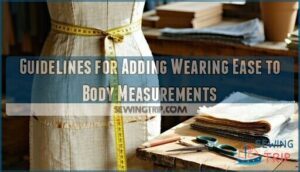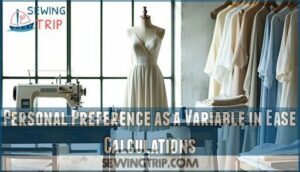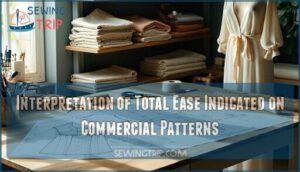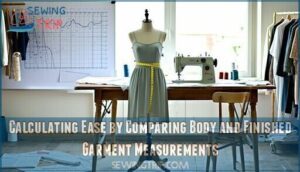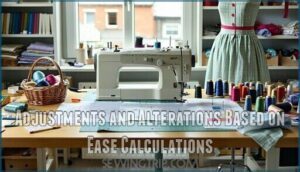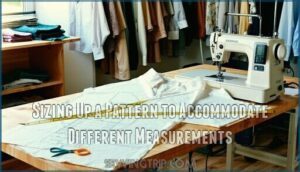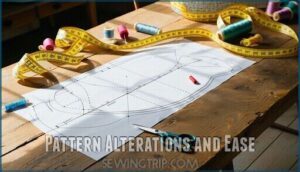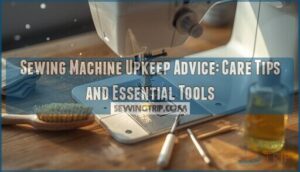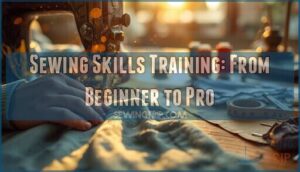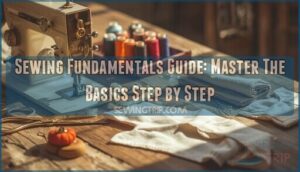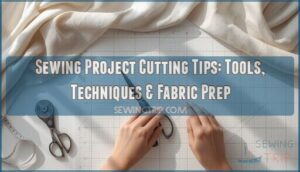This site is supported by our readers. We may earn a commission, at no cost to you, if you purchase through links.
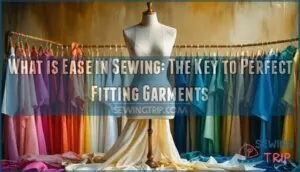
Think of it as breathing room that transforms a paper pattern into wearable clothing.
You’ll encounter two types: wearing ease (2-4 inches for comfortable movement like reaching and sitting) and design ease (which creates the garment’s intended silhouette).
Without proper ease, you’d end up with clothing that feels like a straightjacket or splits at the seams when you move.
The magic happens when you calculate ease by adding your body measurements plus wearing ease plus design ease.
Different fabrics need different amounts – knits require less than woven materials since they naturally stretch.
Mastering ease calculations reveals the secrets professional seamstresses use to create perfectly fitted garments.
Table Of Contents
- Key Takeaways
- Understanding Ease in Sewing
- Determining The Amount of Ease
- Working With Commercial Patterns
- Accessibility of Ease Charts From Major Pattern Companies Online
- Interpretation of Total Ease Indicated on Commercial Patterns
- Calculating Ease by Comparing Body and Finished Garment Measurements
- Adjustments and Alterations Based on Ease Calculations
- Sizing Up a Pattern to Accommodate Different Measurements
- Pattern Alterations and Ease
- Achieving The Perfect Fit With Ease
- Reader Interactions
- Frequently Asked Questions (FAQs)
- Conclusion
Key Takeaways
- You need ease to move comfortably – Without proper ease, you’ll end up with clothes that feel like a straightjacket or will split when you bend, reach, or sit down.
- There are two types of ease you’ll work with – Wearing ease (2-4 inches) gives you room for daily movement, while design ease creates your garment’s intended style and silhouette.
- Calculate ease by adding measurements together – Take your body measurements, add wearing ease, then add design ease to determine your final garment size.
- Your fabric choice affects how much ease you’ll need – Knits require less ease since they stretch naturally, while woven fabrics need more room to accommodate movement without strain.
Understanding Ease in Sewing
You’ll discover that ease is the secret ingredient that transforms a good-fitting garment into a great one.
Understanding the difference between wearing ease and design ease will help you create clothes that move with your body while achieving your desired style.
Definition of Ease in Sewing
Ease in sewing is the extra space you build into garments beyond your body measurements.
Ease is what turns a tight squeeze into wearable comfort for every stitch and style
This breathing room makes the difference between clothes that feel like a straightjacket and ones that move with you naturally.
- Definition: Ease equals finished garment measurements minus your body measurements
- Purpose: Creates comfort, movement freedom, and prevents fabric strain during daily activities
- Calculation: Body measurements plus wearing ease plus design ease equals final garment size
Understanding ease calculation transforms your sewing from guesswork into precision tailoring.
Distinction Between Wearing Ease and Design Ease
Understanding these two pillars of garment construction reveals your sewing success.
Wearing ease provides the essential room you need for daily activities like reaching, sitting, and breathing comfortably.
Design ease shapes your garment’s silhouette and style impact.
Together, they determine your garment’s final personality.
Mastering the concept of ease stitch techniques is vital for achieving the perfect fit in various garments.
| Aspect | Wearing Ease | Design Ease |
|---|---|---|
| Purpose | Movement comfort | Styling effect |
| Amount | 2-4 inches typical | Varies by trend |
| Control | Body-dependent | Designer choice |
Different garment silhouettes require different ease levels.
A fitted blouse needs minimal design ease but adequate wearing ease, while oversized jackets embrace generous design ease.
Your fabric choices also influence ease requirements—stretchy knits need less wearing ease than woven cottons.
Mastering this distinction helps you select proper fit types and apply appropriate sewing techniques for your desired look.
Importance of Ease for Movement and Style
Perfect garment fit depends on understanding how ease affects both your daily movements and overall style.
When you’re calculating garment ease, you’re balancing comfort levels with style factors to create clothing that moves with you seamlessly.
Consider these key benefits of proper ease allowance:
- Movement Ease: Your arms can reach overhead without fabric strain
- Comfort Levels: You can sit, bend, and walk without restriction
- Style Factors: The silhouette maintains its intended shape throughout wear
Your fabric choice plays a huge role here.
Stretch fabrics need less ease than woven materials because they naturally accommodate movement.
Getting sewing for comfort right means your finished garments won’t pull across your back when you hug someone or create uncomfortable bunching when you sit down.
This balance between function and fashion is what separates homemade clothes from professionally fitted pieces.
Ease as a Necessary Component for Comfortable Clothing
Beyond just looking good, your garments must actually work with your body’s natural movements.
Comfort is the real secret to clothes you’ll reach for every day
Clothing fit depends heavily on garment ease, which creates the breathing room between fabric and skin.
When you’re selecting fabric choice and planning your garment silhouette, you’re basically designing comfort levels into every seam.
Think of ease allowance as your garment’s built-in flexibility system.
Without proper sewing techniques that account for fit preferences, you’ll end up with clothes that restrict rather than liberate.
Sewing for comfort means understanding that ease in sewing isn’t optional—it’s what transforms stiff fabric into wearable art.
Consider these scenarios where ease makes all the difference:
- Reaching overhead to grab something from a high shelf without splitting seams
- Sitting down comfortably without your shirt pulling tight across your back
- Taking a deep breath during a presentation without buttons straining
- Bending over to tie your shoes without fabric bunching uncomfortably
Relationship Between Ease and Garment Fit
Mastering the relationship between ease and garment fit transforms your sewing from guesswork into precision.
When you understand how ease calculation affects garment balance, you’ll create clothes that move with your body while maintaining their intended silhouette.
Proper ease in sewing considers your body proportions and fabric choice, ensuring each garment fits like it was made just for you.
| Fit Analysis Element | Impact on Garment | Your Action |
|---|---|---|
| Wearing Ease | Allows comfortable movement | Add 2-4 inches at bust/chest |
| Design Ease | Creates intended style silhouette | Follow pattern’s ease recommendations |
| Fabric Behavior | Affects how ease translates to fit | Test stretch and drape beforehand |
| Body Proportions | Influences ease distribution | Adjust ease at key fitting points |
Understanding this relationship means you’ll know exactly why that store-bought dress doesn’t fit right, while your handmade garments feel perfectly custom-made to your unique shape.
Determining The Amount of Ease
Figuring out how much ease to add isn’t just about following a chart—it’s about understanding what your body needs and what look you’re after.
You’ll need to take into account factors like your fabric choice, the garment style you want, and your personal comfort preferences to get the perfect fit, considering what will provide you with the desired comfort.
Factors Influencing The Amount of Wearing Ease Needed
Several key factors determine how much wearing ease you need for comfortable, well-fitting garments. Your body type affects ease requirements—muscular builds need more room across shoulders and chest.
Movement needs vary dramatically; activewear demands extra ease while formal wear requires less. Fabric choice plays a vital role since stretchy knits need minimal ease compared to rigid wovens.
Garment style influences ease calculations, with fitted silhouettes using less than loose designs. Personal preference ultimately guides your comfort level.
Understanding garment ease basics is essential for achieving the perfect fit in your sewing projects, considering complete concepts and garment style to ensure a comfortable and well-fitting garment, which is a key factor in wearing ease.
Guidelines for Adding Wearing Ease to Body Measurements
When you’re ready to add wearing ease to your body measurements, follow these practical steps for accurate garment fitting.
Start by taking precise body measurements while wearing your typical undergarments, then apply these sewing techniques:
- Measure twice, cut once – Double-check your body measurements at bust, waist, and hips for reliable ease calculations
- Consider your comfort zone – Add 2-4 inches for fitted garments, 4-6 inches for relaxed fits, depending on your movement preferences
- Account for fabric behavior – Woven fabrics need more wearing ease than knits since they don’t stretch with your body
Your ease in sewing decisions should reflect both comfort and style goals.
Remember, proper ease calculations prevent that "sausage casing" effect while ensuring your sewing patterns translate into flattering, wearable garments that move with you naturally.
Impact of Fabric Choice on Ease Requirements
Your fabric choice dramatically changes your ease requirements.
Knit fabrics with stretch need less ease since they naturally conform to your body—sometimes you’ll even use negative ease for a snug fit.
Woven fabrics require more generous ease because they don’t give.
Think of it this way: a stretchy jersey needs maybe 2 inches of ease, while a crisp cotton might need 4-6 inches for the same comfort level.
Texture matters too—bulky fabrics like corduroy need extra room, while smooth silks can handle closer fits.
Determining Design Ease Based on The Desired Garment Style
Design ease shapes your garment’s personality through deliberate silhouette choices.
A flowing maxi dress needs generous design ease for graceful movement, while a fitted blazer requires minimal ease to maintain sharp lines.
Your style preferences guide these decisions—romantic styles embrace extra fullness, structured pieces demand precision.
Consider how design ease interacts with fabric choices and body proportions to achieve your fit objectives and desired garment silhouette.
Understanding fabric weight considerations is vital in selecting the right fabric for your sewing project to guarantee the desired ease and drape.
Personal Preference as a Variable in Ease Calculations
Your personal preferences in ease calculations determine how your garments will look and feel on your body.
Everyone’s comfort zone differs – some love that second-skin feeling while others prefer room to breathe.
Think of ease as your clothing’s personality: it reflects who you’re and how you move through the world.
When calculating ease in sewing, consider these personal fit factors:
- Comfort level – Do you feel confident in fitted clothing or prefer looser silhouettes that don’t cling?
- Lifestyle needs – Active days require different ease than office settings or special occasions.
- Body confidence – Choose ease amounts that make you feel your absolute best, regardless of trends.
- Fabric choice compatibility – Your style preferences should work with your selected materials for ideal results.
Remember, standard ease calculations are starting points.
Your personal preferences trump pattern recommendations every time.
Trust your instincts about clothing fit preferences – you know your body best.
Working With Commercial Patterns
When you’re ready to use a commercial pattern, you’ll find that most major pattern companies provide ease information right on the envelope or in their online charts.
Understanding how to read and interpret this data will help you choose the right size and make any necessary adjustments before you start cutting your fabric.
Accessibility of Ease Charts From Major Pattern Companies Online
Online Pattern Access has revolutionized how sewers find ease information, though availability varies dramatically between pattern company websites.
McCall’s, Vogue, and Butterick offer detailed ease charts online with clear categories from close-fitting to very loose.
However, Simplicity Creative Group’s Digital Ease Guides are inconsistent, often requiring you to check pattern envelopes instead.
When official ease charts vanish from websites, Sewing Community Forums become lifesavers, sharing updated links and user-created summaries.
Smart sewers bookmark multiple Pattern Company Websites and rely on community resources when Ease Calculation Tools aren’t readily available from manufacturers.
Understanding big four patterns is essential for achieving the perfect fit.
Interpretation of Total Ease Indicated on Commercial Patterns
Commercial patterns display total ease values that reveal the secret to perfect garment fit.
When you examine pattern envelopes or instruction sheets, you’ll find finished measurements listed alongside body measurements.
This pattern ease information shows exactly how much extra room the designer included.
Reading these measurement guides helps you understand whether you’re getting wearing ease for comfort or design ease for style.
Smart sewers compare these numbers to their body measurements before cutting fabric.
Your fabric choice can influence how this sewing ease definition translates into the final fit, making interpretation key to successful results.
Calculating Ease by Comparing Body and Finished Garment Measurements
Breaking down ease in sewing isn’t rocket science once you master this simple comparison method.
You’ll subtract your body measurements from the pattern’s finished garment measurements to determine ease.
Here’s your step-by-step approach:
- Take accurate body measurements using proper measurement techniques with a flexible tape measure
- Find finished garment measurements on the pattern envelope or instruction sheet specifications
- Apply sewing formulas by subtracting body measurements from finished measurements to calculate total ease
This comparison reveals exactly how much room you’ll have for movement and style preferences.
Understanding sewing pattern making measurements is essential for achieving the perfect fit in your garments.
Adjustments and Alterations Based on Ease Calculations
Once you’ve calculated your ease requirements, making adjustments and alterations becomes straightforward.
You’ll need to modify patterns systematically to achieve the perfect fit. Start by comparing your desired ease calculations against the pattern’s built-in measurements. Utilizing accurate sewing patterns is vital for successful garment construction.
| Adjustment Type | When to Use | Method |
|---|---|---|
| Grading Between Sizes | Body measurements span multiple sizes | Blend cutting lines smoothly |
| Length Adjustments | Torso/limb proportions differ | Add/subtract at lengthen/shorten lines |
| Circumference Changes | Ease calculations show significant differences | Adjust side seams proportionally |
| Dart Modifications | Bust/waist ease affects fit | Relocate or resize darts |
| Sleeve Adjustments | Arm measurements require different ease | Modify cap height and width |
These pattern modifications guarantee your garment fitting goals align with your personal ease calculations. Remember, small adjustments often yield better results than dramatic changes.
Sizing Up a Pattern to Accommodate Different Measurements
If your measurements don’t match a pattern straight out of the envelope, don’t sweat it—sizing up is your ticket to a custom fit.
Grab your tape measure and compare body measurements to the pattern’s ease charts. Tweak the pattern sizing for comfort and movement.
Here’s how you can approach it:
- Use Measurement Conversion for accurate adjustments.
- Analyze Fit by checking garment modifications.
- Apply Sewing Techniques to keep seams smooth and your garment fit just right.
Pattern Alterations and Ease
When you alter a pattern, you’ll need to keep ease in mind so your finished garment isn’t too tight or baggy.
It’s a bit like adjusting a recipe—if you skip an ingredient, things can get awkward fast.
Factoring Ease Into Pattern Size Adjustments
Pattern Sizing is like tuning an instrument—you want harmony between body and garment.
When making sewing adjustments, don’t forget ease in sewing. Use sewing ease charts and always check your fabric choices.
For a balanced garment fit, keep these in mind:
- Double-check ease calculations
- Adjust pattern adjustments for comfort
- Watch for negative ease with stretchy fabrics
- Maintain consistent ease throughout
Example of Sizing Up a Pattern to Accommodate a Different Size
Sizing up a pattern feels a bit like deciphering a secret code. You’ll start with Measurement Guidance, comparing your body to the sewing pattern sizing.
Use Pattern Scaling and Sizing Techniques—slash and spread, or add seam allowances. Fit Adjustment is key for hips, bust, or waist.
With a few pattern adjustments, you’ll get a garment fit that’s comfortable. Ease charts help guide your changes, making size conversion simple.
Understanding pattern grading basics is essential for achieving a perfect fit. Here’s a quick comparison:
| Area | Original Size | Sized-Up Adjustment |
|---|---|---|
| Bust | 38" | 40" |
| Waist | 30" | 32" |
| Hips | 40" | 42" |
Calculating The Added Ease Needed When Altering Patterns
Once you’ve picked a new size, it’s time to figure out how much extra room you need.
Grab your tape measure, note your body measurements, and compare them to the finished garment size.
Subtract your measurements from the garment’s, and voilà—that’s your Pattern Ease.
Factor in Fabric Choice, use solid Measurement Tips, and trust reliable Sewing Formulas for accurate clothing fit adjustments.
Ensuring Ease Remains Consistent When Adjusting Patterns
You’ve just calculated the added ease for your sewing pattern adjustments—now keep that ease consistent across your garment.
When making Fit Adjustments or Sewing Modifications, watch for Garment Balance so one part isn’t swimming while another is squeezed.
Here’s how to stay on track:
- Double-check Ease Calculations
- Compare Pattern Ease at key points
- Match seam allowances
- Keep ease in sewing symmetrical
- Test with a muslin
The Importance of Maintaining a Balanced Fit During Pattern Alterations
When you tweak a pattern, keeping garment balance in check is like walking a tightrope—one misstep and your masterpiece could hang awkwardly.
Fit adjustments and pattern modifications demand sharp eyes and steady hands. Use smart sewing techniques and careful alteration methods to guarantee ease in sewing stays consistent.
If you’ve ever ended up with a lopsided shirt, you know how important it’s to maintain fit and symmetry for a polished, flattering result.
| Fit Adjustments | Pattern Modifications |
|---|---|
| Check shoulder width | Add dart shaping |
| Balance side seams | Adjust hem length |
| Align sleeve caps | Modify waist curve |
| Compare bust ease | Refine armhole fit |
The key to achieving a well-balanced garment is to make careful alteration methods and ensure that all modifications are done with steady hands.
Achieving The Perfect Fit With Ease
You want your clothes to fit just right, not so tight you’re afraid to sit or so loose you could smuggle snacks in your sleeves.
By understanding how to balance ease for comfort and style, you’ll turn every project into a flattering, wearable success.
Tailoring Ease to Individual Preferences for Comfort and Style
Once you’ve adjusted your pattern, it’s time to make ease in sewing work for you.
Think of ease as your personal fit toolkit—add a little more wearing ease for cozy sweaters, or dial up design ease for dramatic garment silhouettes.
Let your style preferences guide you, and don’t forget how Fabric Choice affects comfort.
Ease calculation isn’t just math; it’s about feeling good in what you wear.
Negative ease? Great for knits that hug, if that’s your vibe!
Ensuring Ease Enhances The Overall Look of The Garment
Between fabric drape and Garment Silhouette, ease in sewing is your secret weapon for style enhancement.
Ease calculations let you fine-tune fit preferences, making sure wearing ease supports movement while negative ease shapes a sleek look.
The right amount of ease keeps your garment fit sharp—not baggy or stiff—so your clothes look intentional, not accidental.
Balancing Wearing Ease and Design Ease for Optimal Results
Striking the right balance between wearing ease and design ease is like seasoning soup—too little, and it’s bland; too much, and it’s overwhelming.
Start by factoring in your Fit Preferences and Garment Silhouette. Think about how you want to move and look in your finished piece.
Ease Calculation is key: add body measurements to recommended wearing ease, then layer on design ease for style. Consider Fabric Choice—stretchy knits may need negative ease, while wovens require more room.
Use Sewing Techniques like muslin fitting to test comfort and appearance. Pattern companies offer handy charts for reference.
By blending comfort, movement, and style, you’ll master ease in clothing and enjoy freedom in every stitch.
Final Considerations for Achieving The Desired Fit With Ease
When you’re wrapping up Fit Adjustments, double-check your Ease Calculations and Garment Balance.
Don’t let style considerations or measurement techniques trip you up.
Ease in clothing isn’t just about numbers—wearing ease, design ease, and negative ease all play a part.
Trust your instincts, measure twice, and remember: a well-fitted garment feels like freedom, not a straightjacket.
The Role of Ease in Creating Well-fitting and Flattering Clothing
Between you and a perfectly custom-made garment stands ease in clothing—it’s the secret sauce for balancing body proportions, garment silhouette, and fit preferences.
By mixing wearing ease, design ease, or even negative ease, you’ll master sewing techniques that flatter your shape.
Remember, fabric choice matters; stretchy knits hug curves, while woven fabrics need more breathing room for comfortable garment fit.
Reader Interactions
You’ve learned the essentials of ease, but now it’s your turn to put these principles to work and share your experiences.
Whether you prefer a relaxed fit or like your knits snug, let’s tackle ease together—no tape measure required for a good conversation.
Wearing Ease
Movement Ease is your secret weapon for mastering garment comfort.
When you’re doing a Fit Analysis, use these steps to dial in wearing ease:
- Measure your body and jot down those body measurements.
- Decide how much extra space (ease) you want for natural movement—think sitting, reaching, or hugging your dog.
- Compare finished garment measurements to your body for a balanced garment fit.
Smart Sewing Techniques make sure you never feel squeezed or lost in fabric, and Movement Ease is key to achieving this, ensuring you have enough wearing ease for comfort.
Design Ease
After you’ve got wearing ease sorted for comfort, it’s time to play with design ease.
This is where you shape your style preferences and control how your garment hangs or flows.
Want a dramatic silhouette or a relaxed vibe? Design ease lets you add volume, adjust drape, and chase trends without sacrificing garment fit.
Think of it as your secret sauce for personalizing clothes—whether you’re after a sharp, custom look or something breezy and oversized.
Remember, every tweak in ease changes how your sewing project looks and feels, so experiment until your wardrobe matches your vision.
Negative Ease
If you’re chasing that body con look with knit fabric, negative ease is your secret weapon.
In sewing, negative ease means your finished garment is actually smaller than your body measurements, relying on the fabric’s stretch percentage for comfort and movement.
Think of it like a friendly squeeze—snug, but never suffocating.
Always check pattern compatibility and fabric stretch before cutting, or your fitted garments might turn into a wrestling match.
Mastering negative ease makes garment construction feel like magic.
Understanding Your Body’s Personal Ease Requirements
After learning about negative ease, it’s time to focus on your own body’s personal ease requirements. You’re not a one-size-fits-all pattern, so why should your clothes be?
Think about how your body shape, daily routine, and fabric choices affect comfort and fit. Don’t let measurement accuracy slip—grab that tape measure and get honest.
Here’s what to keep in mind:
- Body shape and movement needs
- Lifestyle factors (active, sedentary, etc.)
- Fabric drape and stretch
- Measurement accuracy
- Personal style and wearing ease preferences
When considering these factors, remember that your clothes should reflect your lifestyle factors and personal style, ensuring the best fit and comfort for your unique needs.
Save This Article to Your Sewing Pinterest Board
When you’re sorting out your personal ease requirements, don’t forget to pin this article to your sewing Pinterest board.
Just click Save, pick your favorite board, and you’re set for quick access to Sewing Inspiration, Project Ideas, and Pattern Organization.
Pinning helps you track tips on wearing ease, design ease, and negative ease, plus share your Skill Sharing wins.
Join the Community Showcase—chat with fellow sewists and swap clever tricks for conquering tricky sleeves and smooth finishes.
Shop Easy to Sew Patterns Here
Ready to break free from tricky instructions? Jump into our collection of beginner patterns featuring simple designs and quick projects.
You’ll find downloadable PDFs for all sewing levels, making it easy to master wearing ease, design ease, and even negative ease.
Whether you’re after a breezy top or a comfy pair of pants, these sewing patterns are crafted for hassle-free fitting. Explore various pattern options for your next project.
Grab your favorite style, and let your creativity take the wheel!
Frequently Asked Questions (FAQs)
What is sewing ease?
Sewing ease is extra room you’ll add beyond your body measurements, ensuring your garments fit comfortably and allow natural movement without restricting bending, sitting, or stretching.
What is ease in a pattern?
Pattern ease refers to the extra space built into a sewing pattern beyond your body measurements.
It’s the difference between your actual measurements and the finished garment’s dimensions, ensuring you’ll have room to move comfortably in your completed piece, which is made possible by the inclusion of pattern ease.
Why is sewing ease important?
Like a perfectly crafted glove that moves with your hand, ease guarantees your garments won’t restrict movement, create uncomfortable pulling, or result in unflattering bunching and wrinkles throughout your day.
What is wearing ease?
Wearing ease is the minimum extra room you’ll add beyond your body measurements to guarantee comfort and natural movement in your finished garment.
Why is ease important?
Proper ease guarantees you’ll move comfortably without restriction while maintaining your garment’s intended silhouette.
Too little creates tightness and strain; too much produces shapeless, unflattering results that compromise your polished appearance.
What is the difference between wearing ease and design ease?
You’ll encounter two distinct types: wearing ease gives you freedom to move comfortably, while design ease creates the silhouette and style you’re after in your garment.
How much ease should I add?
Add ease based on your garment type and personal preference. Check pattern charts: fitted garments need 5-10cm, loose styles require 15-25cm. Test with muslins first.
Is ease the same as seam allowance?
You’ll never confuse these again once you grasp this fundamental difference.
Ease is extra space built into your garment’s dimensions for movement and style, while seam allowance is the fabric margin you trim away during construction, and ease is a crucial aspect of garment design.
How to calculate ease in sewing?
Calculate ease by subtracting your body measurement from the finished garment measurement.
For example, if your bust measures 36 inches and the garment’s finished bust is 40 inches, you’ve got 4 inches of ease.
What are the different types of ease in sewing patterns?
Like knights needing room in their armor, you’ll encounter three main types of ease in sewing patterns: wearing ease provides basic comfort and movement, design ease creates the garment’s intended silhouette and style.
Negative ease fits tightly using fabric stretch.
Conclusion
Sure, the tailors of yore must’ve chuckled at modern sewers frantically googling "what is ease in sewing" while their hand-stitched doublets fit like gloves.
Understanding what’s ease in sewing transforms your projects from restrictive disasters into comfortable, stylish successes.
You’ve learned that proper ease calculations—combining wearing ease and design ease—create garments that move with you while maintaining their intended silhouette.
Remember, fabric choice matters, patterns guide you, but your preferences rule.
Master ease, and you’ll sew like those smug historical tailors.
- https://www.craftsy.com/post/what-is-ease-in-sewing
- https://patternlab.london/home/what-is-ease-in-pattern-making-basic-pattern-making/
- https://mignonpriderdesign.wordpress.com/tutorials/trade-secrets/sewing-with-ease/
- https://www.asg.org/adding-ease-to-your-garment/
- https://www.uen.org/cte/family/clothing-1/downloads/construction/ease.pdf


